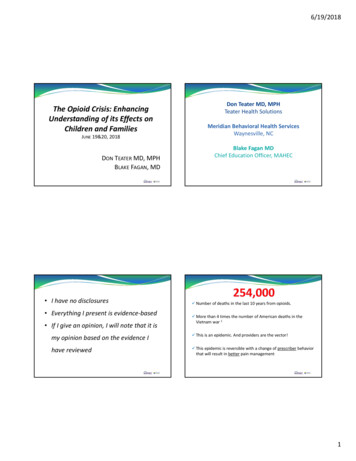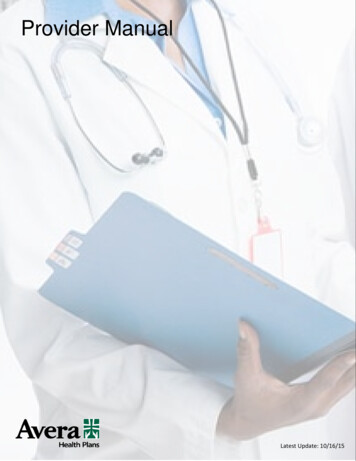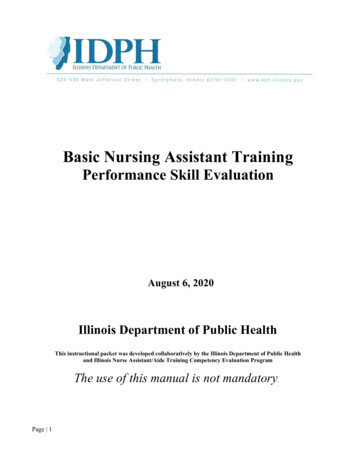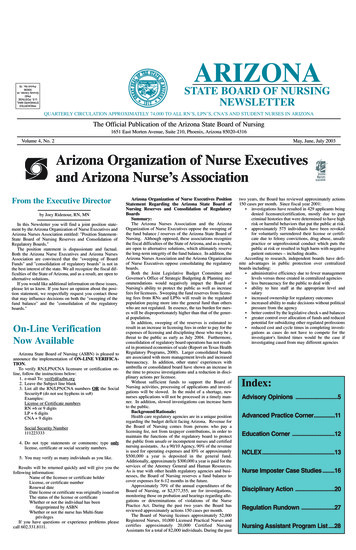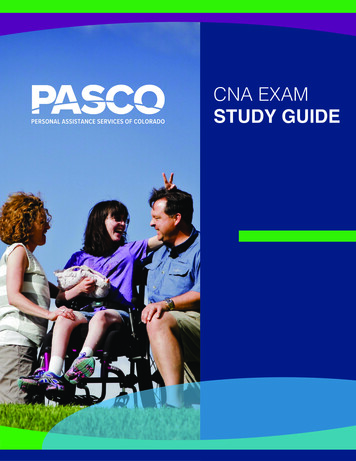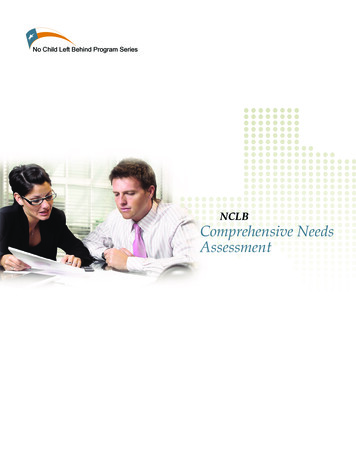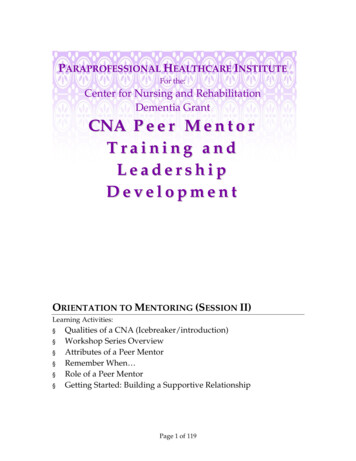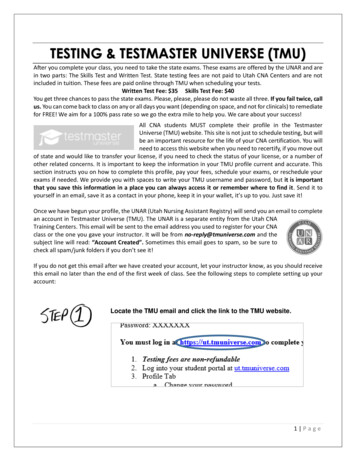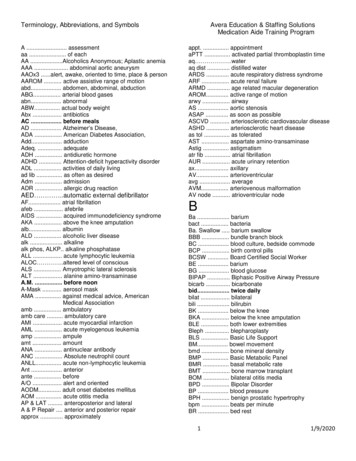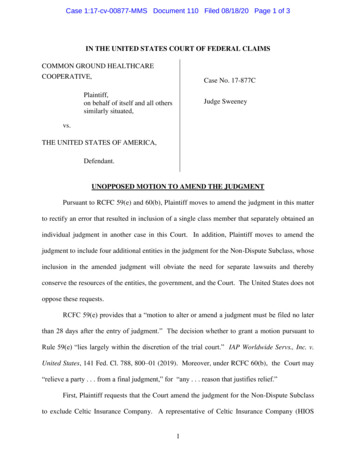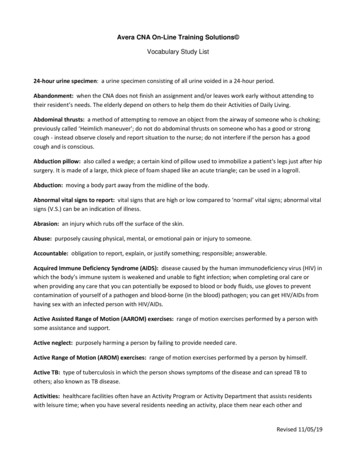
Transcription
Avera CNA On-Line Training Solutions Vocabulary Study List24-hour urine specimen: a urine specimen consisting of all urine voided in a 24-hour period.Abandonment: when the CNA does not finish an assignment and/or leaves work early without attending totheir resident’s needs. The elderly depend on others to help them do their Activities of Daily Living.Abdominal thrusts: a method of attempting to remove an object from the airway of someone who is choking;previously called ‘Heimlich maneuver’; do not do abdominal thrusts on someone who has a good or strongcough - instead observe closely and report situation to the nurse; do not interfere if the person has a goodcough and is conscious.Abduction pillow: also called a wedge; a certain kind of pillow used to immobilize a patient's legs just after hipsurgery. It is made of a large, thick piece of foam shaped like an acute triangle; can be used in a logroll.Abduction: moving a body part away from the midline of the body.Abnormal vital signs to report: vital signs that are high or low compared to ‘normal’ vital signs; abnormal vitalsigns (V.S.) can be an indication of illness.Abrasion: an injury which rubs off the surface of the skin.Abuse: purposely causing physical, mental, or emotional pain or injury to someone.Accountable: obligation to report, explain, or justify something; responsible; answerable.Acquired Immune Deficiency Syndrome (AIDS): disease caused by the human immunodeficiency virus (HIV) inwhich the body’s immune system is weakened and unable to fight infection; when completing oral care orwhen providing any care that you can potentially be exposed to blood or body fluids, use gloves to preventcontamination of yourself of a pathogen and blood-borne (in the blood) pathogen; you can get HIV/AIDs fromhaving sex with an infected person with HIV/AIDs.Active Assisted Range of Motion (AAROM) exercises: range of motion exercises performed by a person withsome assistance and support.Active neglect: purposely harming a person by failing to provide needed care.Active Range of Motion (AROM) exercises: range of motion exercises performed by a person by himself.Active TB: type of tuberculosis in which the person shows symptoms of the disease and can spread TB toothers; also known as TB disease.Activities: healthcare facilities often have an Activity Program or Activity Department that assists residentswith leisure time; when you have several residents needing an activity, place them near each other andRevised 11/05/19
encourage a discussion or other activity, pet therapy is a common activity that residents enjoy – it istherapeutic for some residents to enjoy animals.Activities of Daily Living (ADLs): personal daily care tasks, such as bathing, dressing, caring for teeth and hair,toileting, eating and drinking, walking, and transferring.Acute care: care given in hospitals and ambulatory surgical centers for people who have an immediate illness.Acute illness: sudden new illness; usually short duration.Adaptive: adaptive behavior is a type of behavior that is used to adjust to another type of behavior orsituation.Adaptive equipment: types of equipment or tools that allow a person to be able to perform their own caresmore independently (special added devices to help them adapt, such as special feeding spoons, etc.)Addiction: is a chronic brain disease that causes compulsive substance use despite harmful consequences.Additive: a substance added to another substance, changing its effect.Adduction: moving or adding a body part toward the midline of the body.Admission: the CNA helps with an admission by transporting the resident to their room; assisting them withtheir belongings; taking vital signs and weight and recording them; encourage resident/family to bring a fewfavorite items from home to help with adjusting to the facility.Adult daycare: care given at a facility during daytime working hours for people who need some help but arenot seriously ill or disabled.Advance directives: Advance directives are legal documents that allow you to spell out your decisions aboutend-of-life care ahead of time; can include a living will that spells out the person’s wishes/treatments theperson want if they are dying or permanently unconscious, including refusing care. Durable power of attorneyis a document that names their health care proxy; the proxy is someone the person trusts to make healthdecisions for them if they are unable to do so.AED: automatic external defibrillator; assesses heartbeat and applies electrical shock to the heart whennecessary.Affected side: a weakened side from a stroke or injury; also called the weaker or involved side.Ageism: prejudice toward, stereotyping of, and/or discrimination against the elderly.Agitated: the state of being excited, restless, or troubled.Agitation: the state of feeling irritation or restless; best to be calm, make sure the person is safe and try againlater.Agnostics: persons who claim that they do not know or cannot know if God exists.Revised 11/05/19
AIDS dementia complex: a group of symptoms, including memory loss, poor coordination, paralysis, andconfusion, that appear together in the late stages of AIDS.Alarm: the nursing assistant should not shut off the alarm of an IV pump or other pump, or similar type ofequipment - instead, notify the nurse.Alternating pressure mattress: special mattress used to alternate pressure with low air loss to bestredistribute pressure of skin and tissue and prevent skin breakdown.Alternative medicine: practices and treatments used instead of conventional methods.Alzheimer’s disease: a progressive, incurable disease that causes tangled nerve fibers and protein deposits toform; most common type of dementia. As with all dementia, requires staff to be patient and understanding;person has limited attention span, for example, the resident doesn’t fully dress themselves; use short, simpledirections; resident’s with Alzheimer’s and/or dementia need frequent rest periods; residents may notcomplete all dressing (example: may forget to put on pants or button shirt or put on footwear) due todecreased attention span (forgetful of task sequence); be calm and reassure them in a soft, calm voice; may behelpful for some residents to be provided care in a special, more secure environment or unit that has a moreestablished, consistent routine.Ambulate or ambulation: to walk; allow person to rest when needed with ambulation.Ambulation: walking; when ambulating a resident using a gait belt, grasp under the belt with fingers pointingupward and stay to the side and one step behind.Ambulatory: capable of walking.Amputation: the removal of some or all of a body part, usually a foot, hand, arm or leg.Amputee: to transfer an amputee, use 2 staff and a Hoyer lift.Anatomy: anterior front; ventral on abdominal/stomach side; posterior towards back; dorsal on backside; superior upper; inferior lower portion; divide the abdomen into quadrants (in 4 parts, upper right,lower right, upper left, lower left).Anemia: disorder lacking hemoglobin in the red blood cells (RBCs); often due to lack of iron intake; need RBCsto transport oxygen to body tissues.Anesthesia: use of medication to block pain during surgery and other medical procedures.Anger: a strong feeling of annoyance, displeasure, or hostility. If a person is angry, make sure they are safe,and try again later; also a stage of grief/dying (stages of grief and dying: shock and denial, anger, bargaining,depression, acceptance – person doesn’t go through all stages or may stay in one stage); all people areaffected by death; if family asks when resident is going to die, ask them if they want to talk and if they wishyou to sit with them – if yes, notify nurse; talking about someone’s death helps with grieving.Angina pectoris: chest pain, pressure, or discomfort; notify nurse immediately if resident has chest pain.Revised 11/05/19
Anorexia: an eating disorder in which a person does not eat or exercises excessively to lose weight.Antibacterial: active against bacteria; use disinfectants to clean surfaces and equipment BEFORE next use; useantibacterial wipes, soap, disinfectants to prevent cross-contamination of bacteria and pathogens.Antiembolic stocking/elastic stocking/TED hose: used to decrease edema (swelling) and prevent a blood clot(thrombus) or a blood clot that has broken off and is traveling to the lung or brain (emboli or embolus); if TEDhose is too tight, check circulation and notify the nurse; put on in the morning prior to resident getting out ofbed.Antimicrobial: an agent destroys or resists pathogens.Anxiety: common in dementia; use a calm, slow approach, and calm environment; be flexible with routines.Anxiety: uneasiness or fear, often about a situation or condition. Signs of anxiety can include: Feelings ofapprehension or dread, trouble concentrating, feeling tense and jumpy, anticipating the worst, irritability,restlessness, watching for signs of danger, feeling like your mind’s gone blank, pounding heart, sweating,stomach upset or dizziness, frequent urination or diarrhea, shortness of breath, tremors and twitches, muscletension, headaches, fatigue, insomnia; surge of overwhelming panic, feeling of losing control or going crazy,heart palpitations or chest pain, feeling like you’re going to pass out, trouble breathing or choking sensation,hyperventilation, hot flashes or chills, trembling or shaking, nausea or stomach cramps, feeling detached orunreal.Apathy: a lack of interest.Aphasia: no speech or difficulty with speaking.Apical pulse: the pulse located on the left side of the chest, just below the nipple; need to use a stethoscopeto hear.Apnea: the state of not breathing.Arm lock: position in which the caregiver places his arm under the resident’s armpit, grasping the resident’sshoulder, while the resident grasps the caregiver’s shoulder.Arteries: bring blood away from the heart; high pressure.Arthritis: a general term that refers to inflammation of the joints; causes stiffness, pain, and decreasedmobility.Artificial airway: any plastic, metal, or rubber device inserted into the respiratory tract to maintain orpromote breathing.Aspiration: to inhale food, fluid or foreign material into the lungs; can cause pneumonia or death; for personwho is comatose, to prevent aspiration keep head of bed up or turn head to the side; highest risk of choking oraspirating is when drinking thin liquids (liquids may need to be thickened); residents with strokes or anyneurological deficit have highest risk to aspirate or choke when drinking thin liquids.Revised 11/05/19
Assault: the act of threatening to touch a person without his or her permission.Assisted Living: living facilities for people who do not need skilled, 24-hour care, although they do requiresome help with daily care.Assistive or adaptive devices or equipment: special equipment that helps a person who is ill or disabled orhas other self-care deficits, to perform ADLs or care for themselves; a hearing aid is an adaptive or assistivedevice; any device that helps a person e more independent; example: hand brace for resident withrheumatoid arthritis of the hand.Asthma: a chronic inflammatory disease that causes difficulty with breathing and coughing and wheezing.Atheists: people who claim that there is no God.Atherosclerosis: a hardening and narrowing of the blood vessels.Atrophy: the wasting away, decreasing in size (shrinking), and weakening of muscles from lack of use; range ofmotion can prevent atrophy.Autoimmune illness: an illness in which the body’s immune system attacks normal tissue in the body.Autonomic dysreflexia: sudden onset of life-threatening emergency situation that results in extremely high BP(systolic often above 200); signs are: intense headache, profuse sweating, facial erythema (redness), goosebumps, nasal stuffiness, feeling of doom; generally occurs with person with spinal cord injury at cervical spine(neck); situations trigger BP to rise.Autonomic nervous system: part of nervous system that controls involuntary or automatic actions such asbreathing, digestion, heartbeat.Autopsy: exam of dead body to determine cause of death.Axilla: underarms; axillary.Axillary: (there is no u in axillary); taking a temperature under the arm space.Bacteria: microscopic living organisms, usually one-celled, that can be found everywhere. They can bedangerous, such as when they cause infection (pathogen), or can be helpful.Bargaining: trying to make a deal, example with God, for more time (stage of death).Baseline: initial observations and values that can then be compared to future measurements.Basted: coated with juices or other liquid during roasting.Bath water temperature: 95-105 degrees, but not more than 110 degrees Fahrenheit.Bathing: if a resident has anxiety or become combative during bathing or showering, have another personhold their hands; bath schedule can be found in the care plan; encourage resident independence – allow themto do as much as they can for themselves.Revised 11/05/19
Battery: touching a person without his or her permission.Bed cradle: an arched, stainless steel device that is place over the bed frame to prevent the weight of bedlinens on a person’s legs or feet.Bed height: elevate the bed when doing cares to prevent yourself from getting back strain; never leave aresident alone or if you have stepped away from the bed when bed is elevated – keep bed at lowest positionwhen you are not directly at the bedside.Bed rail: same as ‘side rail’; may be elevated (put in up position) so person can use to turn or prevent injury;use of bed/side rails is a restraint unless MD ordered/on care plan and documented per facility policy.Bedpan: portable pan that women urinate in and both men and women defecate (have a bowel movement)in; roll person on their side and place bed pan (sitting on the most flat part of the bedpan) and then elevatethe head of the bed (unless person must remain flat); as soon as you remove the bedpan, observe urine orstool for unusual appearance or odor (notify nurse if needed – do not discard until nurse observes if unusual).Bedrest: a medical order or treatment in which a person lies in bed for all or most of some period of time togain health benefit; person is to remain in bed.Behavior: often related to person’s unmet needs, are frustrated or fearful; do not show anger; crying: sootheand tell them it’s ok to cry and you will listen; try to comply with reasonable requests; aggressive: protect self,make safe, use calm approach, return later; best way to determine behavior is to observe the behaviordirectly; consistently collect and document behaviors and report findings to the nurse.Behavioral care plan: plan of care developed for all staff to use that offers interventions (what to do) whenperson exhibits (shows) behavior.Benign prostatic hypertrophy: a disorder that occurs in men as they age, in which the prostate becomesenlarged and causes pressure on the urethra, leading to frequent urination, dribbling of urine, difficulty instarting the flow of urine, and urinary retention.Benign tumors: tumors that are considered non-cancerous.Bias: prejudice.BID: twice daily (think of BID as bilateral or two, or BI meaning two or bicycle which has 2 wheels)Binder: device that holds dressings in place and/or helps support weakened body parts.Biohazard: waste that contains infectious waste or pathogens; biohazardous or infectious waste that containsblood or body fluids; place biohazardous waste in special containers labeled with biohazardous wastesign/signage to prevent contamination of that waste to others; label all specimens, place in a ‘biohazardlabeled bag/container’ and transport to lab immediately or ASAP.Bipolar disorder: type of mental illness that causes a person to swing from deep depression to extremeactivity.Revised 11/05/19
Bladder training: also called timed toileting or timed voiding; this can prevent residents from incontinence orurinating in inappropriate areas; toileting every 2 hours or per care plan.Bloodborne Pathogens Standard: federal law that requires that healthcare facilities protect employees frombloodborne health hazards.Bloodborne pathogens: microorganisms found in human blood that can cause infection and disease inhumans.Body alignment: keep spine straight, not curved or twisted.Body language: facial expression; tone of voice; posture; gestures.Body mechanics: the way the parts of the body work together whenever you move; keep your back straight;bend at the knees and lift with your arms and legs; widen your stance by having your legs apart toapproximately shoulder width or better; keep objects like boxes close when picking up, carrying, and moving –to prevent back strain or other injury.Bone: rigid tissue that protects organs and works together to allow the body to move.Bony prominences: areas of the body where the bone lies close to the skin.Bowel and bladder training: requires patience, empathy, positive reinforcement; program can improvepersonal dignity and control.Bowel obstruction: stool in rectum or colon that is either partly or completely blocked.Bowel training or bowel re-training program: if a person is incontinent of stool or BM, it is helpful to start abowel retraining program to better control bowel movements and develop a regular pattern of elimination;encourage fluids and fiber if permitted; offer to toilet routinely.Brachial pulse: the pulse inside the elbow, about 1 - 1 1/2 inches above the elbow; feel (palpate) brachialartery and when found, place stethoscope over that pulse.Broken equipment or damaged equipment: first remove from service immediately so no one is harmed, thenreport that it is broken per facility policy.Bronchiectasis: condition in which the bronchial tubes are permanently enlarged, causing chronic coughingand thick sputum; may be result of chronic infections and inflammation.Bronchitis: an irritation and inflammation of the lining of the bronchi.Bulimia: an eating disorder in which a person binges, eating huge amounts of foods or very fattening foods,and then purges, or eliminates the food by vomiting, using laxatives, or exercising excessively.Burnout: to take of yourself so as not to become frustrated and stressed with your employment.Bursitis: inflammation of bursa (fluid-filled sacs that cushion many joints).Calculi: kidney stones that form when urine crystallizes in the kidneys.Revised 11/05/19
Call light: always make sure that all residents have a call light available to ask for help (even if they areunconscious or doesn’t understand how to use it), as it is a safety concern; be aware that when staff answercall lights promptly it helps the person to feel secure and feel safe (security); if call light is placed on theunaffected (strong) side, it allows person to be more independent and also is a safety measure.Cancer: uncontrolled growth of abnormal cells in body cells and tissues.Cane: used to assist with mobility; single-tip or a quad cane (4 tips); person is to hold cane on their strongside; cane is moved first, the person then moves the weaker foot, followed by stronger foot/leg.Cardiac arrest: sudden stoppage of the heart.Cardiopulmonary Resuscitation (CPR): medical procedures used when a person’s heart or lungs have stoppedworking.Care conference: staff and family work together to develop the resident care plan; families are important indeveloping care plan because they know the resident best and can help staff best care for the resident; nursingassistants can attend to offer suggestions and ideas related to observations they have made.Care of dying: provide the same care as for the living; speak in normal tone and volume.Care of person with blindness or vision loss: when approaching a blind person, initiate the greeting using anormal tone of voice; identify yourself and then inquire if your assistance is desired. If so, touch your hand tothe back of their hand as a signal or them to take your arm; let blind or visually impaired people know you areleaving.Care plan: overall goals of care and the needs of the resident are outlined in the care plan; it’s also a plan tohelp with continuity of care (staff caring for resident in same way).Care team: all members of the healthcare team; very important to work together for continuity (stability) ofcare and to work on shared goals with the resident, by exchanging information; care plan includes the overallgoals of care.Carrier: person has disease that can be passed on to others but doesn’t show symptoms of the disease.Cast care: do not place linens, plastic, blanket on cast; do not place on hard surface; reposition/turn residentfrequently; support cast when turning or repositioning; watch for decreased circulation – coldness of limb orskin, cyanosis (bluish skin color), swelling, pain, numbness; check skin around cast for irritation; do not placeobjects inside cast.Cataracts: milky or cloudy spots develop in the eye; clouding of the lens of the eye, causing vision loss.Catastrophic reaction: overreacting to something in an unreasonable way that is socially unacceptable.Catheter care: provide proper pericare; obtain new water; remove contaminated gloves, wash hands, applynew gloves; separate labia (female) or draw back foreskin if any (male); using clean/new cloth and soap orwipe/per policy, wipe in circular motion around insertion site of urinary meatus and gently clean down theRevised 11/05/19
length of catheter 4-6 inches; repeat wiping 3 or more times (careful not to pull on catheter); rinse, pat dry;(ensure the retracted foreskin over penis is gently drawn back over the head/tip of penis).Catheter strap: attached to the person’s leg to prevent excessive pulling or traction on the indwellingcatheter.Catheter: a thin tube inserted into the body that is used to drain or inject fluids; keep catheter bag lower thanthe level of the bladder; check catheter and empty every shift or per facility policy or care plan.Causative agent: a pathogen or microorganism that causes disease.Cells: basic units of the body that divide, develop, and die, renewing tissues and organs.Centers for Disease Control and Prevention (CDC): a government agency under the Department of Health andHuman Services (HHS) that issues information to protect the health of individuals and communities.Centers for Medicare & Medicaid Services (CMS): a federal agency within the U.S. Department of Health andHuman Services that is responsible for Medicare and Medicaid, among many other responsibilities.Central nervous system: part of the nervous system that is composed of the brain and spinal cord, whichtogether regulate all bodily functions.Cerebellum: the cerebellum, in the back of the brain, controls balance, coordination and fine muscle control(e.g., walking); functions to maintain posture and equilibrium.Cerebrovascular Accident (CVA): a condition that occurs when blood supply to a part of the brain is cut offsuddenly by a clot or a ruptured blood vessel; also called a stroke; place food on the strong side of the mouthwhen assisting with eating; do not do BP on arm with paralysis.Cesarean section: a surgical procedure in which a baby is delivered through an incision in the mother’sabdomen.Chain of infection: way of describing how disease is transmitted from one living being to another.Chancres: open sores.Changes in the urinary system with age or aging: difficulty fully emptying the bladder; maximum volume ofurine that the bladder can hold decreases; a person's ability to delay urination after first sensing a need tourinate declines; the rate of urine flow out of the bladder and into the urethra slows; increased bladder spasmcan cause urinary incontinence; the amount of urine that remains in the bladder after urination is completed(residual urine) increases; may have to urinate more frequently and have a higher risk of urinary tractinfections.Chart: medical record that must be kept confidential; should NOT be locked – need to be accessible for staff tosee if needed.Charting: writing down important information and observations about residents.Revised 11/05/19
Chest tubes: hollow drainage tubes that are inserted into the chest during a sterile procedure to drain air,blood, or fluid that has collected inside the pleural cavity.Cheyne-stokes: type of breathing pattern where the person breathes several times and then stops breathing;slow, irregular respirations or rapid, shallow respirations; often common near death.Chickenpox: a highly contagious viral illness that strikes nearly all children.Child abuse: the physical, sexual, or psychological mistreatment of a child.Child neglect: the purposeful or unintentional failure to provide for the needs of a child.Chlamydia: sexually transmitted disease that causes yellow or white discharge from the penis or vagina andburning with urination.Chronic illness: a disease or condition that develops slowly and is long-term or long-lasting.Chronic kidney failure: condition that occurs when the kidneys cannot eliminate certain waste products fromthe body; also called chronic renal failure.Chronic obstructive pulmonary disease (COPD): a chronic lung disease that cannot be cured; causes difficultybreathing; elevate head to ease breathing.Circadian rhythm: the 24-hour day-night cycle.Circulatory body system: consists of three independent systems that work together: the heart(cardiovascular), lungs (pulmonary), and arteries, veins, coronary and portal vessels (systemic); responsible forthe flow of blood, nutrients, oxygen and other gases, and hormones to/from cells.Circumcision: the surgical removal of part of the foreskin of the penis.Cite: in a long-term care facility, to find a problem through a survey.Clarification or to clarify: to make sure there is understanding.Claustrophobia: fear of being in a confined space.Clean catch specimen: urine specimen that does not have the first and last urine included.Clean: in health care, a condition in which objects are not contaminated with pathogens; linens in the linencloset are clean, not sterile.Clear liquid diet: fluids that you can see through such as cranberry or apple juice, coffee, tea, jello, broth,popsicles; absolutely no food or chunks of food in the liquid.Clergy: if the resident/patient requests a visit from a religious entity (clergy), notify the nurse.Clichés: phrases that are used over and over again and do not really mean anything.Closed bed: a bed completely made with the bedspread and blankets in place.Revised 11/05/19
Closed fracture: a broken bone that does not break the skin.Clostridium difficile (C-diff, C. difficile): bacterial illness that causes diarrhea and can cause colitis(inflammation of the large colon); infectious disease.Cognition: the ability to think logically and quickly.Cognitive impairment: loss of ability to think logically; concentration, memory affected.Cognitive: related to thinking and learning.Cold application: cool or cold cloth or ice pack (ice pack must NOT be placed directly on the skin; wrap intowel); cool or cold CONSTRICTS the blood vessels and decreases edema (means swelling); adding moisturemakes the application more intense; check the cold pack frequently!Colitis: inflammation of the large intestine that causes diarrhea and abdominal pain; also called irritable bowelsyndrome.Colorectal cancer: cancer of the gastrointestinal tract; also known as colon cancer.Colostomy: surgically-created diversion of stool or feces to an artificial opening through the abdomen.Coma: person is unconscious; do not give fluids or food (NPO); provide oral care every 2 hours; may be able tohear, overhear, and remember conversations held within hearing distance.Combative: violent or hostile; make safe and try later.Combustion: the process of burning.Communicable: disease that can be passed on or transferred to another; ‘infectious’.Communication: the process of exchanging information with others; all communication requires a sender ofinformation, the actual message, and the receiver of the message; good communication includes making sureyou use language and words (vocabulary) that the person can understand; make sure you communicateaccurately.Compassionate: caring, concerned, considerate, empathetic, and understanding.Complementary medicine: treatments that are used in addition to the conventional treatments prescribed bya doctor.Complex carbohydrates: carbohydrates that are broken down by the body into simple sugars for energy;found in foods such as bread, cereal, potatoes, rice, pasta, vegetables, and fruits.Complication: unexpected condition or change in sick person who may get worse.Concentrated formula: a type of formula for infants that is sold in small cans and must be mixed with sterilewater before using.Revised 11/05/19
Condom catheter: catheter that has an attachment on the end that fits onto the penis; also called an externalor “Texas” catheter, to drain urine.Confidentiality: the legal and ethical principle of keeping information private; share resident information withhealthcare staff only.Confusion: the inability to think clearly.Congestive heart failure (CHF): a condition in which the heart is no longer able to pump effectively; bloodbacks up into the heart instead of circulating.Conscientious: guided by a sense of right and wrong; having principles.Conscious: being mentally alert; awareness of surroundings, sensations, and thoughts.Constipation: the inability to eliminate stool, or the difficult and painful elimination of a hard, dry stool;causes are medications, decreased fluid intake, and immobility; due to slowed digestive system; prevention ofconstipation: high fiber diet, increase fluids, exercise more.Constrict: to narrow or tighten.Contracture: the permanent and often very painful stiffening of a joint and muscle; tightening and/orshortening of a muscle.Conversion of cc/mL to ounces or ounces to cc/mL: cc cubic centimeter; mL milliliter; 1cc 1m
Revised 11/05/19 Avera CNA On-Line Training Solutions Vocabulary Study List 24-hour urine specimen: a urine specimen consisting of all urine voided in a 24-hour period. Abandonment: when the CNA does not finish an assignment and/or leaves work early without attending to their resident's needs. The elderly depend on others to help them do their Activities of Daily Living.
